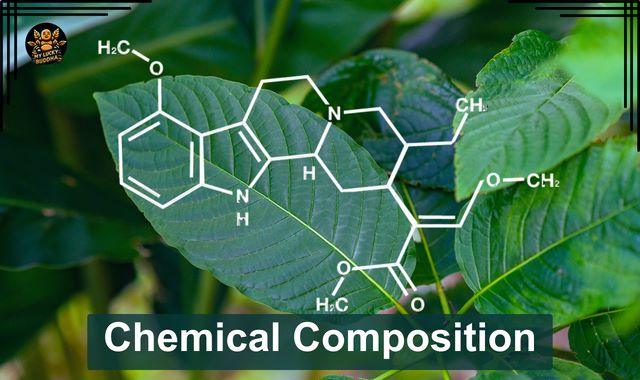Chemical Composition of Kratom: An In-Depth Analysis of Its Alkaloids and Effects
Kratom, or Mitragyna speciosa, is a tropical tree native to Southeast Asia. Known for its complex chemical composition, kratom contains over 40 alkaloids, with mitragynine and 7-hydroxymitragynine as the primary active compounds. Traditionally used in Southeast Asian medicine and ceremonies, kratom’s leaves now gain attention for their well-ness enhancing properties, which range from stimulating to sedative, depending on dosage and strain.
Researchers study kratom’s pharmacological effects due to its potential therapeutic applications and safety concerns. Understanding its chemical makeup is essential for assessing its effects and potential drug interactions.
Key Takeaways
- Kratom is a complex herb from Southeast Asia with over 40 alkaloids.
- The primary alkaloids, mitragynine and 7-hydroxymitragynine, influence its effects.
- Kratom’s safety and therapeutic potential are currently topics of scientific investigation.
Kratom Chemical Composition and Alkaloids
Kratom, scientifically known as Mitragyna speciosa, has a complex chemical profile, predominantly comprised of various alkaloids. These compounds are primarily responsible for the plant’s biologic effects, with mitragynine and 7-hydroxymitragynine being the most prominent.
Primary Alkaloids
The alkaloid content in kratom leaves is rich and diverse, but two compounds stand out for their abundance and biological activity:
- Mitragynine: This is the most prevalent alkaloid found in kratom, accounting for up to 66% of the total alkaloid content in the leaves.
- 7-hydroxymitragynine: Although present in lower concentrations, this compound is potent and has been studied for its effects
Secondary Metabolites and Alkaloid Speciociliatine
Besides the primary alkaloids, kratom contains other compounds that contribute to its chemical makeup:
- Secondary metabolites: These include various other alkaloids and flavonoids, which may influence the overall effects of kratom.
- Speciociliatine: This is one of the several secondary alkaloids found in kratom, though in smaller quantities compared to mitragynine and 7-hydroxymitragynine.
Kratom Chemical Composition Characterization Techniques
To understand kratom’s chemical composition, scientists employ various analytical methods:
- Spectroscopic data & NMR spectra: These techniques are essential for elucidating the structures of kratom’s alkaloids.
- HRESIMS & ECD data: High-resolution electrospray ionization mass spectrometry (HRESIMS) and electronic circular dichroism (ECD) provide detailed information on the molecular composition and chiral properties of the compounds.
- Metabolomics: This field of study gives insights into the biosynthesis and the presence of metabolites in kratom, painting a broader picture of its chemistry.
Pharmacology and Biological Effects
Kratom (Mitragyna speciosa) contains a complex array of alkaloids that interact with various receptors in the brain, producing a spectrum of pharmacological effects. The plant’s most studied alkaloids, mitragynine and 7-hydroxymitragynine, engage with opioid receptors, influencing mood.
Opioid Receptor Interactions
Kratom alkaloids, notably mitragynine, exhibit affinity for opioid receptors, especially the μ-opioid receptor. Opioid receptor binding activity is chiefly responsible for the analgesic properties observed in pharmacological studies. Binding to these receptors can trigger a cascade of biological effects.
- Mitragynine: Predominant alkaloid, less potent than 7-hydroxymitragynine
- 7-hydroxymitragynine: Higher potency, substantial contributor to analgesic effects
G-Protein Signaling and Functional Selectivity
Upon binding to opioid receptors, kratom alkaloids initiate G-protein signaling. This can result in a more nuanced response, termed functional selectivity, differing from traditional opioids. Such activity can vary, leading to effects that range from sedation to stimulation, and may influence the potential for dependence and tolerance.
- G-protein signaling: Mitigates adverse side effects compared to β-arrestin pathway signaling
- Functional selectivity: May reduce respiratory depression risk, unlike typical opioids
- Cytochrome P450 enzymes: Involved in the metabolism of kratom, affecting its pharmacokinetics
Central Nervous System Impact
Beyond opioid receptor interactions, kratom’s alkaloids affect the central nervous system through multiple pathways. In vitro studies suggest additional receptor systems may be implicated in kratom’s diverse effects, such as those regulating mood, alertness, and stress response.
- Alkaloid speciofoline: A lesser-known compound in kratom that may play a role in CNS effects
- Biological effects: Include analgesia, sedation, euphoria, and enhanced alertness, depending on the dose and specific alkaloid profile.
- Disclaimer: The information provided in this article is for educational purposes only and does not constitute medical advice. Kratom is not intended to diagnose, treat, cure, or prevent any disease. Always consult with a healthcare professional before using any new supplement or substance. The legal status of Kratom varies, so please check local laws before purchasing or using it.


